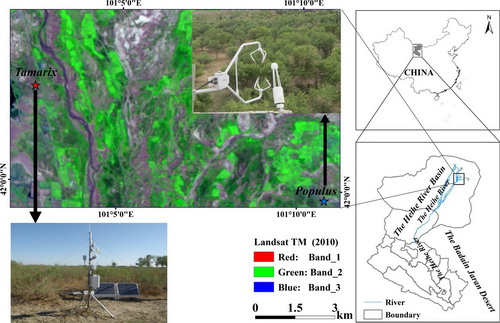Comparable Water Use of Two Contrasting Riparian Forests in the Lower Heihe River Basin, Northwest China
Updatetime:2017-12-15From:
【Enlarge】【Reduce】
Understanding forest ecosystem evapotranspiration (ET) is crucial for water-limited environments, particularly those that lack adequate quantified data such as the lower Heihe River basin of northwest China which is primarily dominated by Tamarix ramosissima Ledeb. and Populus euphratica Oliv. forests.
Accordingly, we selected the growing season for 2 years of two such forests under similar meteorological conditions to compare ET using the eddy covariance (EC) technique.
During the growing seasons, daily ET of T. ramosissima ranged from 0.3 to 8.0 mm day-1 with a mean of 3.6 mm day-1, and daily ET of P. euphratica ranged from 0.9 to 7.9 mm day-1 with a mean of 4.6 mm day-1 for a total of 548 and 707 mm, respectively.
The significantly higher ET of the P. euphratica stand was directly linked to high soil evaporation rates under sufficient water availability from irrigation.
When the soil evaporation was disregarded, water use was comparable to two contrasting riparian forests, a P. euphratica forest with a total transpiration of 465 mm and a T. ramosissima forest with 473 mm.
Regression analysis demonstrated that climate factors accounted for at least 80% of ET variation in both forest types.
In conclusion, water use of the riparian forests was low and comparable in these arid regions, which suggest the long-term plant adaptation to the local climate and conditions of water availability.

Map of the Heihe River basin and the locations of the T. ramosissima and P. euphratica stands. (Image by NIEER)
Appendix




